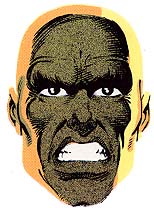Master Order
| Master Order | |
|---|---|
 Master Order. Panel from Marvel Two-in-One Annual #2 (1977). Art by Jim Starlin. | |
| Publication information | |
| Publisher | Marvel Comics |
| First appearance | Marvel Two-in-One Annual #2 (1977) |
| Created by | Jim Starlin |
| In-story information | |
| Species | Cosmic entity |
| Abilities |
|
Master Order is a
Publication history
This section needs expansion. You can help by adding to it. (June 2014) |
The character debuted in
Fictional character biography
The entity embodies order and balance in the universe and is the opposing force to "brother" entity
Master Order and Lord Chaos participated in the congress of metaphysical and abstract beings to determine Thanos' fitness to wield the
During the
Following the restoration of the universe after the Secret Wars, Master Order and his "brother" became disgruntled by Galactus' evolution from a force of destruction to a force of creation.[21] They eventually put Galactus on trial before the Living Tribunal. The Tribunal ruled in Galactus' favor and allowed him to remain in his new form, claiming that the universe being in a new iteration meant the cosmic hierarchy wasn't established anew. Master Order and Lord Chaos took this council to heart, and murdered the Tribunal in order to take his place as the personification of multiversal law.[22]
They attempted to turn Galactus back to his world-devourer form. However, for the same reason Order and Chaos could kill the Living Tribunal, they couldn't stop Galactus from fighting back his transformation. If there wasn't a heriarchy yet, it meant Galactus was also on the same level as Order and Chaos, so they couldn't impose their will on him. Because of this, Order and Chaos traveled to their servant, the In-Betweener, and forced him to become the uniting force in a fusion that combined Master Order and Lord Chaos into a single being, the self-proclaimed new order, Logos.[23]
Powers and abilities
Master Order is an abstract being who embodies the metaphysical concept of Order; as such it has no physical form, although on occasion it has manifested as an image of a disembodied bald male head. It has the ability to control and manipulate time, reality, and space.[24]
It has been implied that Master Order, and its counterpart, Lord Chaos, have vast powers which they use to manipulate events within their sphere of influence in subtle ways.[volume & issue needed] It is known that, through some as yet unknown process, Master Order and Lord Chaos worked together to create the metaphysical being known as the In-Betweener.[volume & issue needed]
Thanos wielding the Infinity Gauntlet ranked Master Order's scale of power as above that of Galactus, but below that of Eternity.[25]
However, later he and Lord Chaos were able to easily kill Living Tribunal by blasting him with energy and also defeat Lifebringer Galactus after transforming into Logos.[26]
Other versions
Master Order and Lord Chaos battle Thanos once more in an alternate universe when he possesses the
References
- ComicBook.com. Retrieved 2023-09-01.
- ^ Roberson, Chris Chan (August 12, 2022). "15 Marvel Characters Who Could Defeat The Celestials". Comic Book Resources. Retrieved 2023-09-01.
- ^ Brayson, Johnny (September 30, 2022). "The 50 Most Powerful Characters In The Marvel Universe, Ranked". Bustle. Retrieved 2023-09-02.
- Marvel.com. Retrieved 2023-09-01.
- ^ Dunphey, Charles (July 8, 2020). "Ranking The 19 Most Powerful Marvel Cosmic Characters". Comic Book Resources. Retrieved 2023-09-01.
- ^ Cacciatore, Francesco (August 20, 2022). "Spider-Man Has Three Different Origins, & They're All Canon". Screen Rant. Retrieved 2023-09-01.
- ComicBook.com. Retrieved 2023-09-01.
- ^ Iacobucci, Jordan (July 16, 2022). "Eternity And 9 Other Crucial Cosmic Entities In Marvel Comics". Screen Rant. Retrieved 2023-09-01.
- ^ Marvel Two-in-One Annual #2 (1977)
- ^ Thor Annual #9 (1981)
- ^ Secret Wars II #6
- ^ Silver Surfer vol. 3, #17 (Nov. 1988)
- ^ Silver Surfer vol. 3, #18 (Dec. 1988)
- ^ Quasar #26 (Sep. 1991)
- ^ Infinity Gauntlet #3 (Sep. 1991)
- ^ Infinity Gauntlet #4 - 5 (Oct. - Nov. 1991)
- ^ Infinity Gauntlet #6 (Dec. 1991)
- ^ Warlock and The Infinity Watch #1 (Feb. 1991)
- ^ Quasar #38 (Sep. 1992)
- ^ New Avengers vol. 3 #30 (April 2015)
- ^ Ultimates (Vol 2) #6
- ^ Ultimates 2 (Vol 2) #2
- ^ Ultimates 2 (Vol 2) #3
- ^ Karbank, Octavio (November 16, 2017). "15 Evil Marvel Gods Too Frightening For The MCU". Comic Book Resources. Retrieved 2023-09-01.
- ^ Thanos Annual #1 (2014)
- ^ Ultimates 2 #2
- ^ Marvel: The End #1 - 6 (2003)
External links
- Master Order at Marvel.com
